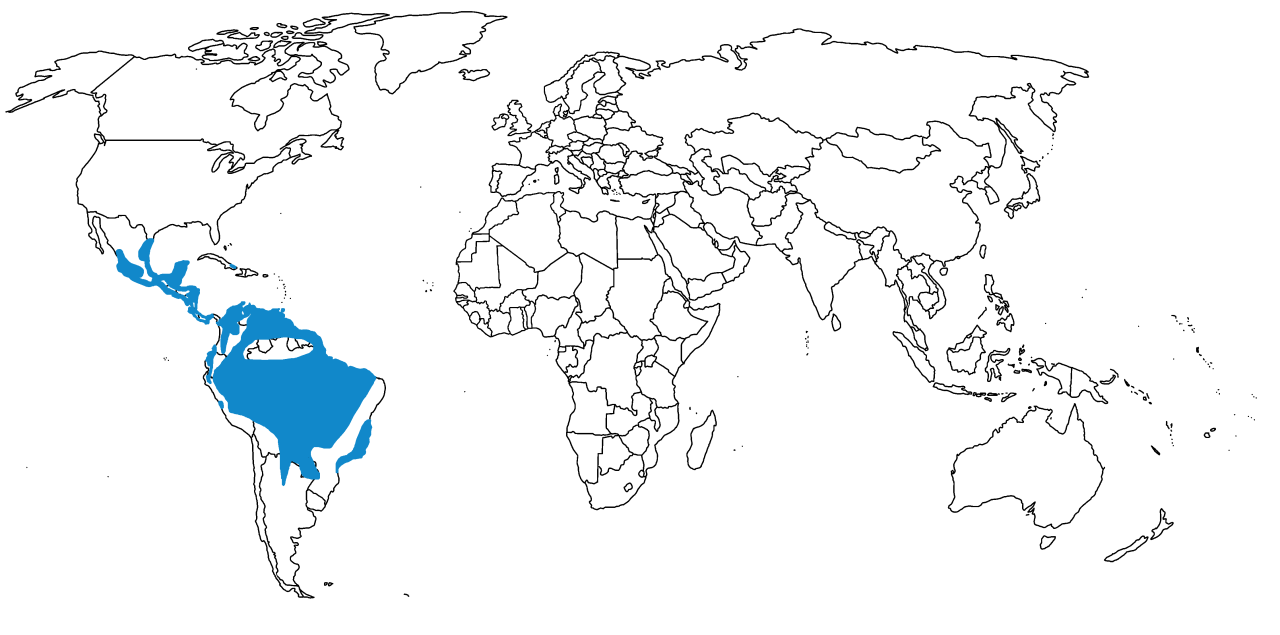Chondrohierax

Hook-Billed Kite by Hector Bottai, CC BY-SA 3.0
Etymology: Coarse Hawk
First Described By: Lesson, 1843
Classification: Dinosauromorpha, Dinosauriformes, Dracohors, Dinosauria, Saurischia, Eusaurischia, Theropoda, Neotheropoda, Averostra, Tetanurae, Orionides, Avetheropoda, Coelurosauria, Tyrannoraptora, Maniraptoromorpha, Maniraptoriformes, Maniraptora, Pennaraptora, Paraves, Eumaniraptora, Averaptora, Avialae, Euavialae, Avebrevicauda, Pygostaylia, Ornithothoraces, Euornithes, Ornithuromorpha, Ornithurae, Neornithes, Neognathae, Neoaves, Inopinaves, Telluraves, Afroaves, Accipitrimorphae, Accipitriformes, Accipitridae,
Referred Species: C. uncinatus (Hook-Billed Kite), C. wilsonii (Cuban Kite)
Status: Extant, Critically Endangered - Least Concern
Time and Place: Within the last 10,000 years, in the Holocene of the Quaternary


The Hook-billed Kites are known from Cuba, Central, and South America, primarily in more humid habitats such as the Amazon basin

Physical Description: These kites range from 38 to 51 centimeters in length, making them fairly large for flighted birds (but not the largest amongst birds of prey by any means, in that respect they’re middle-of-the-road). They are named for their most distinctive feature - a large, heavy, hooked bill. This bill goes well over the underbill, though it varies extensively across individuals in this genus. The birds have strong feet with sharply curved claws, and somewhat short tails. Their wings are ovular in shape, and interestingly enough the females have more interesting color schemes than the males - while all have grey heads with yellow eye patches, the females have brown backs and reddish-brown stripes across their white bellies, while males continue to be grey, with grey stripes. Some morphs of this genus are very dark in color all over. The juveniles are typically dark brown on top and white underneath, with very few stripes.
Diet: These birds feed primarily on tree snails, interestingly enough, which they break apart with their strong beaks. They also will eat some reptiles, frogs, salamanders, craps, and insects, depending on where they live and the food available in that local.

Hook-Billed Kite by Cláudio Dias Timm
Behavior: These are fairly sluggish raptors, all things considered, spending most of their time in the leafy canopy when not flying around. They do fly extensively, though, and are often seen soaring above the rainforest. They will fly until they find a suitable patch of rainforest, go down into the undergrowth, find a snail in its shell, and break the inner whorls of the shell by cracking it with its beak towards the apex of the spire. It will also swallow some smaller snails whole. It will also sit in a perch in the lower canopy to look for snails, or hop between trees. It usually hunts throughout the day, especially during the nesting season. Fairly silent birds, they only tend to make musical chuckling calls to their mate while perched and flying together. They will also make shrill alarm screams in response to danger, and chattering noises to their babies.
When it comes to breeding, they tend to breed whenever the rainy season starts, based on their individual locations. The two birds will circle each other in courtship, low above the canopy, making those noticeable laughing calls. They then build a flimsy stick nest together, between five and seven meters up in the trees or close to the top of the trees - usually precariously placed on thin branches away from the trunk. They lay up to three eggs, usually two, which are incubated for a little over a month. The male will bring food to the female while she incubates, but when the eggs hatch both parents will feed the young. The chicks then fledge in the early to middle rainy season to take advantage of more plentiful snails. These birds are fairly nomadic - with no distinct migratory pattern, they will move in response to availability of food.

Hook-Billed Kites by Mike Ostrowski, CC BY-SA 2.0
Ecosystem: Hook-Billed Kites will live primarily in rainforests, especially in lower canopies and dense understory, as well as in more temperate zones in the Andes mountains. They can also be found in forest edges and clearings, and while they can get up to higher elevations in the Amazon, they are found in lower elevations in more northern locals. The Cuban Kite will be found in more montane gallery forest with extremely tall trees. The young tend to be preyed upon by jays, but the adults don’t have many predators.
Other: These birds are usually very common, but the Cuban species is very much threatened with extinction due to a limited habitat and excessive human hunting. The mainland species may be rarer in some regions, but overall very common and extending its range northward in response to climate change.
Species Differences: The Hook-Billed Kites, as opposed to the Cuban Kites, have dark bills with only slight yellow patches on the lower bill. Meanwhile, the beaks of Cuban Kites are entirely yellow. The Cuban Kite has a much more limited range (in Cuba only), while Hook-Billed Kites are found all over Central and South America. This limited range, in addition to persecution by humans, has led to the critical endangerment of the Cuban Kites.
~ By Meig Dickson
Sources under the Cut
Bierregaard, R.O., Jr, Kirwan, G.M. & Marks, J.S. (2019). Hook-billed Kite (Chondrohierax uncinatus). In: del Hoyo, J., Elliott, A., Sargatal, J., Christie, D.A. & de Juana, E. (eds.). Handbook of the Birds of the World Alive. Lynx Edicions, Barcelona.
Bond, James (1999). A Field Guide to the Birds of the West Indies. Houghton Mifflin Harcourt. p. 55.
del Hoyo, J., Collar, N., Marks, J.S. & Sharpe, C.J. (2019). Cuban Kite (Chondrohierax wilsonii). In: del Hoyo, J., Elliott, A., Sargatal, J., Christie, D.A. & de Juana, E. (eds.). Handbook of the Birds of the World Alive. Lynx Edicions, Barcelona.
Johnson, Jeff A.; Thorstrom, Russell; Mindell, David P. (2007). “Systematics and conservation of the hook-billed kite including the island taxa from Cuba and Grenada” (PDF). Animal Conservation. 10: 349–359.




















